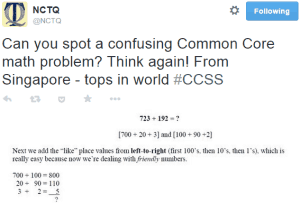This tweet posted by the National Council on Teacher Quality (@NCTQ) caught my eye:

Now, I’ve heard decomposing called “branching” but can’t remember ever seeing this in a Singapore textbook. Where did this problem come from?
It’s nice that NCTQ recognizes Singapore’s Math as “tops in the world.” But it’s discouraging to see methods and terminology that are not a part of the Singapore curriculum attributed to it. Especially in the context of the nasty debate about CCSS. And especially since Singapore’s math curriculum–with its rigor, coherence, and focus–is often cited as a basis for more rigorous standards, including CCSS.
The problem posted is based on the concept of “Number Bonds,” which calls for students to decompose numbers (this is the term used in Singapore and in all major Singapore Math® textbooks distributed in the U.S.). Below, I’ve posted some examples of how this concept is presented in Singapore Math® series available in both the U.S. and Singapore.
This matter points to my BIG concern: As publishers and others adapt Singapore’s Math for the American market, new approaches creep in. These often are not based on the curriculum that helped Singapore’s students go from mediocre to best in the world in a dozen years. I’ve written about this in my comparison of Singapore math textbook series available in the United States.
So my plea to NCTQ: please use examples from an actual Singapore mathematics text when citing the components that make it so successful. And feel free to ask if I can help you find those examples.
Number Bonds problems in Singapore Math® textbooks
Here are some materials covering Number Bonds and “decomposing” numbers from actual Singapore textbooks:
From My Pals are Here, the most-used materials in Singapore:

From the U.S. Edition of Primary Mathematics, available in North America since 2003:

From the Common Core Edition of Primary Mathematics, released in the U.S. market in 2014:

And finally, from Math in Focus:

UPDATE:
Ugh! One more similar tweet from NCTQ.





















Your update attributes the tweet to NCTM not NCTQ.
Thanks! I’ve updated it.
Cassy you are absolutely right. Why change the terminology of a world class system? ‘branching’ is US terminology for an important basic idea: part-part -whole .This idea is essential to understanding decomposition which affects all aspects of mental math. Do teachers believe that “branching” is easier for children to understand? My understanding is that Singapore chooses its math terminology very carefully and deliberately.They clearly believe their children are able to cope with accurate math terms and that these do not need to be substituted by arbitrary terms which contribute little or nothing at all to meaning and understanding-Singapore’s results speak for themselves.
I have also seen other examples of the ‘highjacking ‘ of Singapore Math by people who create a series of worksheets or apps which they claim can demonstrate or provide practice in Singapore math .At best
they show their ignorance ,at worst they are being dishonest.
As an example: An American teacher who gives courses and lectures in Singapore Math and is highly regarded .She insists that “branching ” is used for multiplication in Singapore. This is simply not so -there is no evidence of this in their textbooks . And my experience is that if it’s not there it’s because they don’t want it to be there.
Why dilute an excellent system and instead of second- guessing try to understand what they are doing-after all we are talking about the most successful math system in the world and its world -class materials.